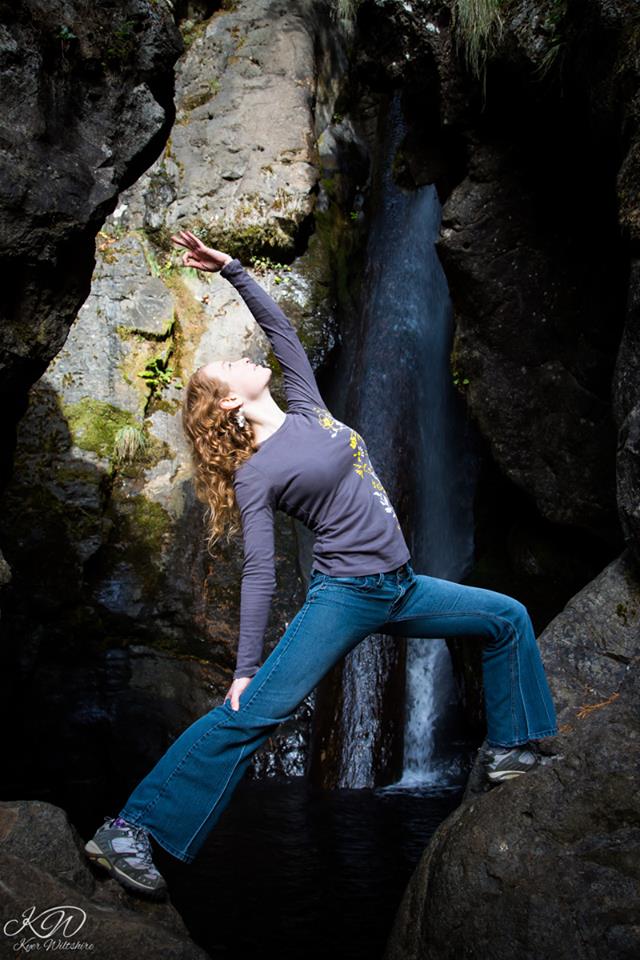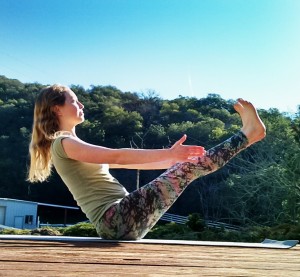 “If you want to conquer the anxiety of live, live in the moment, live in the breath.” -Amit Ray
“If you want to conquer the anxiety of live, live in the moment, live in the breath.” -Amit Ray
This picture is of me performing Viparita Virabhadrasana, or Reverse Warrior pose, and was taken on Mount Hamilton. Photo by Kyer Wiltshire.
Tension or Engagement? How to tell the difference!
My eight year-old daughter, Amelia, just started learning about Geometry in her third grade class. Looking at the never-ending slew of worksheets she brings home, I was reminded of concepts I’d long forgotten: the difference between a ray and a line segment, a line and a vector, obtuse and acute angles, and so on. Once I recovered from my embarrassment over not remembering much third grade math, I was struck by the simple difference between a line segment and a ray. They look the same, except that the ray has an arrow on one end. In other words, the ray is going somewhere – there is movement, while the line segment is just sitting there.
The same difference applies to whether muscular recruitment in yoga or voice practice is defined as tension or healthy engagement. Oftentimes my voice students are surprised if I ask them to engage certain muscles as they are singing. More than one voice student has exclaimed: “But I’m not completely relaxed! Isn’t that tension?” The answer might surprise you: if you are engaging for a reason, if it is helping you to achieve your goals (which hopefully includes taking pressure off of your throat), and if there is dynamic movement and expression – then no, it is not tension – it is healthy engagement.
In asana practice, it is somewhat simpler (but not always easier) to discern: if the muscles that are engaging are helping you enter into or hold a pose, then that is healthy engagement. If your shoulders are lifting up towards your ears in Virabhadrasana II (Warrior II), is that helping you to execute the posture? Is that muscular engagement helping you to lengthen the spine, or open the chest? Of course, the answer is no – it is not a necessary engagement for the pose, and is therefore defined as tension. Once you have determined that the muscular engagement is not helpful, thank your upper trapezius muscles for wanting to help, breathe into that area consciously, and then relax those muscles as much as possible while redirecting towards the truly helpful muscles, engaging them more fully. Hint: the “more helpful” muscles in most postures are usually going to be ones closer to your core, deeper in your body or closer to the spine.
Returning to voice practice, some of the same principles apply. It is still beneficial to ask yourself “Is this muscular engagement necessary and helpful?” and see what intuitive response you get. There are certain common areas of tension for singers: jaw, tongue, outer abdominal wall muscles, the epigastrium/ solar plexus and diaphragm. Sometimes the muscles of the pelvic floor and facial muscles are also unnecessarily tight. Those areas often do need to engage – you need to articulate with your tongue, and of course the diaphragm is involved! So it is not black and white; we cannot uniformly tell these areas to relax completely. How much engagement is necessary, and how much would be categorized as tension?
To explore that question for yourself, take the following steps:
1. Ask: What is the engagement trying to achieve? Is your jaw opening in order to pronounce a vowel, or is the jaw “in cahoots” with your tongue, trying to stabilize your larynx as a substitute for breath support? Try and stay out of judgment as you do your best to answer this question honestly. Humor helps! Once you identify compensatory tension, observe it without judgment, inviting in awareness. Then redirect to the muscle groups you know will truly help you achieve your goals. If you’re not sure about this, consult an experienced teacher.
2. Ask: Is there movement, and if so, in what direction? Here’s where the geometry comes in. Is there a line of energy moving up as well as down the spine? Or is it only moving up? Is there lateral movement out to each side of your body, wrapping around from your back ribs, or out the back of your head? Or all of the above? When I sing and I am truly in “the zone,” I sense dynamic movement of energy upwards, down into the earth, from the periphery of the body to the center, from the core to the periphery, and a strong circulation and vibration through the whole head. These energetic movements correspond to the five Vayus (energetic movements) in yogic tradition, and by bringing them into balance, tension naturally releases.
3. Be efficient. Once you identify that a certain muscular engagement is, in fact, helpful and necessary in some way, then the question is – how much is necessary? The answer is: as little as possible. Our goal is a state of “effortless effort,” in which the energy flows without undue striving, and the engagement is truly only what is necessary.
Remember to stay with an attitude of gratitude and playfulness as much as possible, and enjoy this process of releasing tension. With each layer of tension that releases, your true voice will be more fully revealed!

